Description
Human Resource Information Systems Basics Applications and Future Directions 3rd Edition by Michael J. Kavanagh -Test Bank
Human Resource Information Systems: Basics, Applications, and Future Directions, 3e
by Michael J. Kavanagh and Richard D. Johnson
Chapter 6: Project Management and Human Resource Advice for Human Resource Information Systems Implementation
Multiple Choice
1. GANTT, PERT, and CPM charts are techniques used in:
A. identification of modules to computerize
*B. project management (PM)
C. data flow diagramming
D. utility analysis
2. The final stage of the system development process for an HRIS is:
A. implementation
*B. evaluation
C. maintenance
D. distribution
3. Which one of the following reasons has been identified as a barrier to success in the development and implementation of an HRIS?
*A. project team instability
B. a well-done needs analysis
C. use of PERT
D. use of a Gantt chart
4. An effective plan for HRIS implementation should include:
A. project goals and timetables
B. responsibilities and resources
C. monitoring and reporting mechanisms
*D. all of the above
5. The major advantage in using PM approaches and tools during the SDLC for an HRIS is:
*A. a tighter control over the process to ensure successful implementation
B. a graphical picture of the entire project showing all activities
C. top management support is guaranteed
D. communications are always accurate
6. A method for analyzing a project that calculates the starting and ending times for each activity, determines which activities are critical to the completion of a project is called:
A. the SDLC
B. a Gantt chart
*C. CPM
D. PERT
7. A method for analyzing the tasks involved in completing a given project, the time needed to complete each task, and the minimum time needed to complete the total project is called:
A. the SDLC
B. a Gantt chart
C. CPM
*D. PERT
8. The item developed during the first phase of the SDLC that describes the key stakeholders and seeks to ensure that the right questions are asked so that the right problem is solved is the:
A. project team
*B. project concept
C. work packages
D. project proposal
9. The item developed during the first phase of the SDLC that contains objectives and performance targets (e.g., cost, time, scope) for the HRIS project is the:
A. project timetable
B. project concept
C. work packages
*D. project proposal
10. The item created during the SDLC that defines the order in which activities, tasks and jobs are to be performed, and specific check or monitoring points are established is the:
*A. work breakdown structure
B. project concept
C. work packages
D. project proposal
11. It has been estimated that failure of IT projects costs organizations in the United States alone at least ___________ a year.
A. $500 million
B. $750 million
*C. $100 billion
D. $750 billion
12. The five key factors of PM: schedule, budget, open issues, risks, and communication are assessed during the ____________ ___________ phase.
A. project initiation phase
B. project planning phase
*C. project execution phase
D. project close-out phase
13. The term used to describe when decisions are made during the PM process to implement additional functions beyond what was defined in the project scope is called:
A. reengineering
B. process mapping
C. project add-ons
*D. project creep
14. What are the three general factors that affect successful PM?
*A. time, cost, and scope
B. creep, scope and time
C. cost, management, and creep
D. time, management and creep
15. The primary responsibility of the steering committee in the development and implementation of an HRIS using PM technology and tools is the:
A. provision of additional resources as needed during the project
*B. oversight of the project in terms of progress toward meeting strategic goals
C. contacting external vendors to provide checks on the progress of the project
D. all of the above
True/False
16. The sequence of activities in a project plan that results in the least cost for the project is called the critical path.
A. True
*B. False
17. Effective PM for the HRIS depends completely on a positive relationship between the IT and HR departments.
*A. True
B. False
18. The celebration of the completion of an HRIS project is not a part of the four phases of project management.
A. True
*B. False
19. PM brings a critical capability to the HRIS project—namely, evaluation of the project’s performance by monitoring progress against the planned timetable.
*A. True
B. False
20. One important task for the project steering committee is the development of the project charter.
*A. True
B. False
21. The project charter shows a connection to organizational goals and strategies.
*A. True
B. False
22. The coordination of the members of the steering committee is usually delegated to the administrative assistant of the project sponsor.
A. True
*B. False
23. Sending an email indicating progress on a Gantt chart is a good way to ensure cooperation from both the steering committee and the project team members.
A. True
*B. False
24. One of the major tasks of the PM team is to identify the need for more resources in the early phases of the project.
*A. True
B. False





Be the first to review “Human Resource Information Systems Basics Applications and Future Directions 3rd Edition by Michael J. Kavanagh -Test Bank”